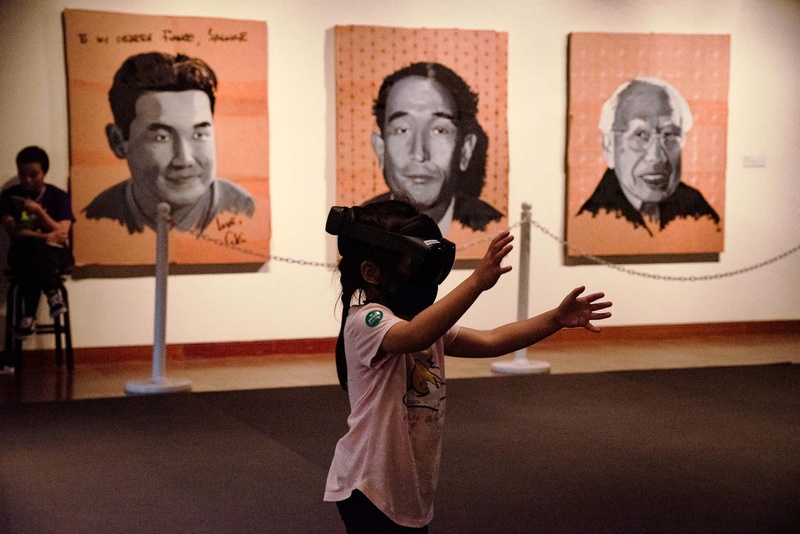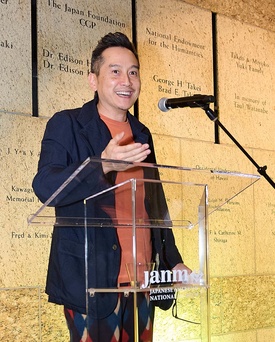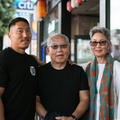The Los Angeles Times art critic Christopher Knight calls JANM’s exhibition, Glenn Kaino: Aki’s Market, “a captivating theater of dreams.” The virtual reality experience depicts an important place in Kaino’s family history—a place that the artist, Glenn Akira Kaino, has never experienced for himself. A place of collective memory, dreams, art, and history.
The virtual corner store and artworks in the exhibition are inspired by his grandparents, Akira and Sachiye Shiraishi, and their small neighborhood market that they ran from 1957–70 in the East Los Angeles neighborhood of City Terrace. Created by artist Kaino (Akira’s grandson and namesake), the exhibition explores the World War II Japanese American incarceration experience through the stories of Kaino, his family, and the community.
As you walk through Kaino’s virtual recreation of his family’s corner store, you are thrust into a dense and organized collage-like space full of his family’s stories, artwork, and community history, all handed down to each successive generation. Born in Los Angeles and raised in Cerritos, California, Kaino began creating at a young age.
“My friends and I would build our own toys and we would get sort of action figures or whatever, but not be able to have or afford the vehicles or any of the settings, and so we would make all of the landscapes. And my first early introduction into making and kitbashing and the idea of using other parts for different projects was making our own toys growing up.”
That concept of kitbashing—creating a new scale model using pieces from other scale model kits—eventually became a central tenet of his art practice. After earning his BA in Fine Art from the University of California, Irvine, and his MFA from the University of California, San Diego, Kaino established a small studio that creates art about challenging issues that are political, engaging, and beautiful.
“I have a chart; I call it the Constellation of Concerns. And it’s about eighteen or so large-scale areas of investigation that have driven my practice for the entirety of my career, including post-coloniality, space-making, magic belief systems. I created a practice that is not able to fit into a category and so we have a multiplicity of categories that the work fits in. But we do have a series of north stars and guiding lights in the studio that sort of have driven all of the activity over the course of my career,” said Kaino.
Aki’s Market is no exception. By investigating the postwar endeavors of his grandparents, he examines the American practice of displacement and transgenerational trauma from World War II incarceration and questions the artifacts of incarceration.
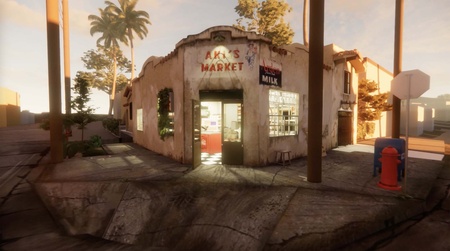
“How are they carried down through the behavior of my parents, and how did their behavior subtly affect my behavior, and how does my behavior affect my children—not just for me, but for the entire community?” asked Kaino. Aki’s Market is one interpretation and answer to that question. He also raises another: How do positive role models of Asian American masculinity contribute to a person’s worth?
“One of the things that was not available to me were positive role models of Asian American masculinity. But what was pervasive were the stories of my grandfather…[for] who I was named after [and] who I’d grown up learning and hearing about,” said Kaino.
Shiraishi passed away before Kaino was born, but Kaino was enamored with the family story of his grandfather being a legendary football player for John H. Francis Polytechnic High School in Los Angeles. According to Dudley Abourisk of the Daily Optimist, Shiraishi was one of fifteen students who won Achievement Scholarships to Occidental College, where he planned to enroll in their premedical program. In addition to being an excellent student, he was involved with his high school’s Japanese Club and a cappella choir and participated in church, the Boy Scouts, and the YMCA, where he was an outstanding fencer.
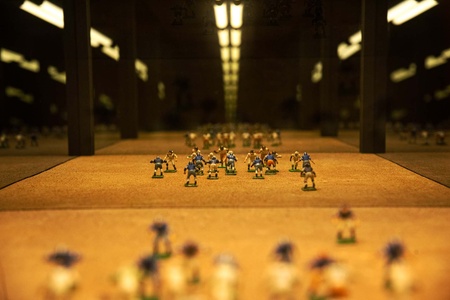
Kaino’s grandmother, Sachiye Shiraishi (née Hosozawa), went to high school in Los Angeles and Heart Mountain High School and was a USO administrative assistant and a member of the Community Activities department at the Heart Mountain concentration camp. The Hosozawa and Shiraishi families were both incarcerated at the Santa Anita temporary detention center but Sachiye and Akira did not know one another during that time.

According to family lore, they met during a dance at Heart Mountain. They were engaged during the spring of 1945 and married in the summer of that same year. Their engagement and wedding announcements were printed in the March 10 and July 28, 1945, issues of the Heart Mountain Sentinel. When they returned to Los Angeles, they ran their corner store in City Terrace. Together they served the Japanese and Latine communities for thirteen years.
Shiraishi passed away two years before Kaino was born, but the artist continued to learn about his grandfather through his family, historical texts, and Los Angeles civic leaders. When he searched for images of his grandparents’ store there were few available. When he asked his family, they were resistant and had difficulty recollecting memories from that period in their lives.
So Kaino dug into his artistic toolkit and used his skill of unlocking memories through layered conversations to recreate a fuller vision of the place that his family affectionately called “The Store.”
“We’ve also collapsed fifteen years of the store’s existence into one moment, so there are products from different cycles of the store. But we’ve also introduced products from now and introduced new iterations of it [and] where my family—some of the storytellers—had gaps in their memories; we’ve filled them in, really connecting the present day to that moment as well. What I’ve been saying is that inventory comes and goes, but the spirit of the store is what stays,” said Kaino.
The virtual reality recreation of the store does have a lot of spirit embodied not only in the products that are on the shelves but in the details such as Shiraishi’s football helmet, the photograph of Olympian Tommie Smith—a reference to Kaino’s previous exhibition, With Drawn Arms: Glenn Kaino and Tommie Smith—and newspaper vending machines displaying a front-page headline about Shiraishi. If you walk slowly through the store you will be sure to catch many of these details.
To aid further understanding of the exhibition as a whole, visitors can read Kaino’s zine which explains the virtual reality installation and surrounding artwork through his perspective. Visitors can also delve into a blog post by art aficionado and JANM Trustee Gordon Yamate, which traces his personal recommendations for experiencing the exhibition. Finally, visitors can also listen to the artist himself talk about what his work means to him in an audio guide on JANM’s website and the Museum’s digital guide on the free app, Bloomberg Connects.
* * * * *
Glenn Kaino: Aki’s Market is at the Japanese American National Museum through Januar 28, 2024. The exhibition explores the transgenerational trauma from the World War II Japanese American incarceration experience through the stories of Kaino, his family, and the community. Through a virtual reality recreation of the store and an installation of related works, Glenn Kaino: Aki’s Market is an exhibition about collective memory where the archival bleeds into the imaginary and where the most advanced technology serves the most personal past.
VR Experience Availability
Tuesday: 12 p.m.–3 p.m.
Wednesday: 12 p.m.–3 p.m.
Thursday: 2 p.m.–6 p.m.
Friday: 12 p.m.–3 p.m.
Saturday: 12 p.m.–4 p.m.
Sunday: 12 p.m.–4 p.m.
© 2023 Helen Yoshida


